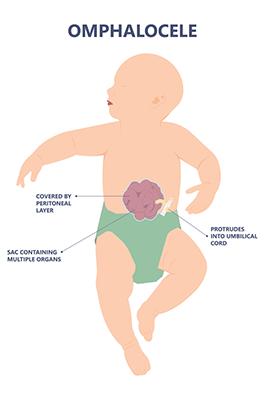In omphalocele (om·pha·lo·cele), the abdominal muscles around the belly button (umbilicus) don’t form correctly leaving only a thin membrane covering the intestine. Omphalocele usually is diagnosed before birth.
Overview
What is omphalocele?

The severity of the defect varies. Some infants have only a small portion of the intestine protruding from the abdomen, and others are born with their entire intestine, along with other abdominal organs such as the liver or spleen, outside of the abdominal cavity and covered by a thin membrane. They also might have an abnormally small abdominal cavity.
Most infants with omphalocele have other congenital defects, such as congenital heart defects. These co-morbidities can complicate management of omphalocele.
Treatment
How is omphalocele treated?
Surgery to repair omphaloceles is complex and should take place as soon as possible following the infant’s delivery to prevent damage to the intestines. Complex or large omphaloceles can require multiple surgeries to complete the repair. This is especially true if the infant’s abdominal cavity is too small to accommodate all of the organs during the initial surgery.
Doctors and Providers
 Adam Craig AlderPediatric Surgeon
Adam Craig AlderPediatric Surgeon Natasha Marie CorbittPediatric Surgeon
Natasha Marie CorbittPediatric Surgeon Diana Leigh DiesenPediatric Surgeon
Diana Leigh DiesenPediatric Surgeon Barbara Anne GainesPediatric Surgeon
Barbara Anne GainesPediatric Surgeon Lauren Ann GilloryPediatric Surgeon
Lauren Ann GilloryPediatric Surgeon Russell HawkinsPediatric Surgeon
Russell HawkinsPediatric Surgeon Charles Robert HongPediatric Surgeon
Charles Robert HongPediatric Surgeon Stephen Mark MegisonPediatric Surgeon
Stephen Mark MegisonPediatric Surgeon Carrie Colleen Buchanan MoorePediatric Surgeon
Carrie Colleen Buchanan MoorePediatric Surgeon Joseph Thomas MurphyPediatric Surgeon
Joseph Thomas MurphyPediatric Surgeon Samir R PandyaPediatric Surgeon
Samir R PandyaPediatric Surgeon Laura Nanka PurcellPediatric Surgeon
Laura Nanka PurcellPediatric Surgeon Faisal Ghulam QureshiPediatric Surgeon
Faisal Ghulam QureshiPediatric Surgeon